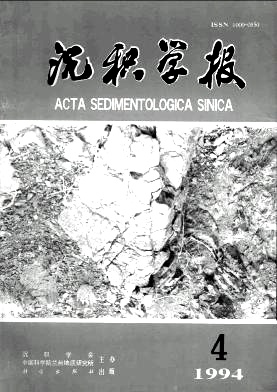Zhou Yanru. Situ一Study on Generative Kerogen in Sedimentary Rock by FTIR一Microspectrometry Technique[J]. Acta Sedimentologica Sinica, 1994, 12(4): 22-30.
| Citation:
|
Zhou Yanru. Situ一Study on Generative Kerogen in Sedimentary Rock by FTIR一Microspectrometry Technique[J]. Acta Sedimentologica Sinica, 1994, 12(4): 22-30.
|
Situ一Study on Generative Kerogen in Sedimentary Rock by FTIR一Microspectrometry Technique
- Received Date: 1994-03-10
- Publish Date:
1994-12-10
-
Abstract
The generative kerogen,although recognized as the most important quantitative index of fossil organic matter before,has new been frequently dealt with in a descriptive or bulk geochemical manner by organic petrographers and petroleum geochemists. This was sufficient,however,to stimulate progress in the understanding of many of the gross factors influencing on the accumulation and transormation of organic matter in the geosphere[1]. In particular,it was helpful fw the application of organic geochemical techniques in petroleum exploration. A true integration of organic geochemistry in modern petroleum exploration strategies aiming at an understanding of generation,migration and accumulation of hydrocarbons as interrelated processes on a geological time scale[2]. Situ study of the micro Forier Transform Infra-Red(FTIR) spectrum (by Nicolet NIC-Plan Microscope)on the generative kerogen and bitumen-free in sedimentary rock (Fig. 6) shows a strong contribution of hydroxyl groups (absorption centered at 3400cm-1).The band is at 2920 and 2850cm-1(CH2 stretching frequencies).Further information on the branching level can be derived from the ratio of the 1375 cm-1band(C-CH3 symmetric bending)and of the 14 5 Ocm-1one (CH2and CH3, asymmetric bending). The presence of aromatic carbons is indicated by the absorption at 1600cm-1 and by broad absorptions centered at 830 and 750cm-1. The 1600cm-1 band is a shoulder of a beoad band centered at 1620cm-1. The latter absorption may be due to olefinic C=C stretching vibrations but its intensity indicates that it does not chiefly correspond to simple non-conjugated olefinic groups. The presence of non-conjugated caroyl is indicated by the intense 1700cm-1band and the small band at 720cm-1$ assigned to long chain alkyl groups with four or more carbon atoms. And it can be also used in studying characters of types, shapes and molecular structure of kerogen and bitumen in the sedimentary rocks. The silo micro-FT'IR spectrometry is a new technique for petroleum geology. Therefore, this suggests that it is very possible to messure in situ kerogen in the sedimentary rock,as very exciting possibility for the petroleum geology and molecular geochemical investigations.
-
References
|
[1]
|
Tissot B. P and welte D. H.,1984, Petroleum Formation and Ocurrence, 2nd edu, 699. |
|
[2]
|
Tissot B. P. and Durand B.,1987,The role of geochemistry in exploration risk evaluation and decision making, Proc. 12th world Pet. Congr. 2.P. 99~122, wiley, London. |
|
[3]
|
Vitorovic p.,1989, Structure elucidation of chemical method, Insoluble Organic matter from Sedimentary Rocks (Edited by Durand B. )P. 301~338, Editions Techniq, Paris. |
|
[4]
|
Vandenbroucke M.,1989 ,Strutture of kerogen as seen by investigation on soluble extracts, Kerogen, Insoluble Organic Matter From Sedimentary Rocks (Edited by Durand B. )P. 415一一443.Editions Technip.Paris. |
|
[5]
|
尼高力中国用户协会,1994,红外显徽镜技术及应用,傅里叶红外光谱技术资料(一),1~12 |
|
[6]
|
Heauchaine J. P. and Rosenthal R. J.,1983.AppVcation of FTIR Microscopy in Polymer Analysis, Nicolet Reprint /preprint RP~4. |
|
[7]
|
Heauchaine J. P. and Rosenthal R. J.,1983, Application of FTIR Microscopy in Forensic Analysis, Nicolet Reprint/Preprint RP一4. |
|
[8]
|
Ganz H and Kalkreuth W, 1987, Application of infrared spectroscopy to the classification of kerogen types in the evaluation of some rock and oil shale potentials, Fuel, 66, 708~711. |
|
[9]
|
周姿如,1993, FT-IR在石油地质上的应用,FT- IR技术与应用研讨会论文集(二),中国光学学会光谱委员会,56-58, |
|
[10]
|
周炎如,1987,傅里叶变换光谱鉴定粘土矿物复合组分的研究,沉积学报,5(1):33~47. |
|
[11]
|
周炎如,童正大,于大森.1992,有机溶质在蒙脱石中“原位”动态吸附研究,沉积学报,16(3);118~125. |
-
-
Proportional views

-






 DownLoad:
DownLoad: